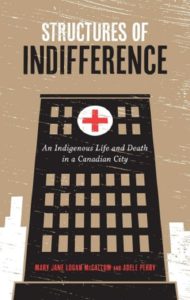Book review: Structures of Indifference
The newly released book “Structures of Indifference: An Indigenous Life and Death in a Canadian City”, looks at what happened to Brian Sinclair, who in 2008, wheeled himself into the Winnipeg Health Sciences Centre. Sinclair was a non-status, middle-aged Anishinaabe. After having been left untreated and unattended for 34 hours in the emergency room, he died from an easily treatable infection.
Authors Mary Jane Logan McCallum and Adele Perry tell the story of how colonialism and a structure of indifference led to the tragic and preventable death of Sinclair.
McCallum and Perry dive into the dark stain of colonial history in Canada by ripping off the Band-Aid and exposing the racist truth. From Indian Residential Schools, treaties policies designed to promote genocide, to how Winnipeg was settled, this book shows how those structures were set up to fail people like Brian Sinclair.
Racism and stereotyping is still alive and well in Canada’s health care system and until that is remedied, the senseless deaths will continue. The care and compassion towards fellow human beings is forgotten or lost on Indigenous Peoples.
It seems as though there is some hope on the horizon with Jordan’s Principle. Jordan’s Principle is a child first and needs-based principle used in Canada to ensure that First Nations children living on and off reserve have equitable access to all government-funded services. In order to ensure substantive equity, this can also include services that are not ordinarily available. It is also available to children who are non-status.
Jordan’s Principle was established by First Nations in response to the death of five-year-old Jordan River Anderson, a child from Norway House who suffered from Carey Fineman Ziter syndrome, a rare muscular disorder that required years of medical treatment in a Winnipeg hospital. After spending the first two years of his life in a hospital, doctors cleared Jordan to live in a family home near the hospital in Winnipeg. However, the federal and provincial governments could not resolve who was financially responsible for the necessary home care. For over two years, the federal and provincial governments continued to argue while Jordan remained in the hospital. In 2005, at the age of five, Jordan died in the hospital; he never had the opportunity to live in a family home.
While Jordan’s Principle may alleviate some of the dysfunction with the health care system and Indigenous youth, more has to be done for our adult and growing Elder population. The Truth and Reconciliation Calls to Action numbers 18-24 addresses the federal and provincial governments to close the gaps when it comes to Indigenous health care and to recognize the distinct health needs of Inuit, Métis and urban Indigenous Peoples. It also calls for the federal government to fund Indigenous Healing Centres.
The personal photos and insight into Brian Sinclair’s life are touching. Sinclair is a person, not just another statistic.
Structures of Indifference: An Indigenous Life and Death in a Canadian City; University of Manitoba Press; paperback $17.95. ISBN 978-0-887558351


